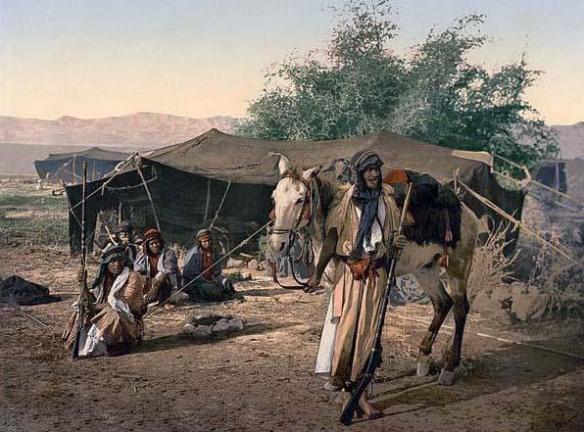Nomadic tribes originally of the Arabian desert, but after the expansion of Islam found across North Africa and into southern Iraq. While the majority of early Muslim rulers and generals were townsfolk from Mecca or Medina, most warriors of the first decades of Arab expansion were tough desert tribesmen, schooled in the razzia tactics and caravan warfare of the Arabian desert. Their style and strategy has often been compared to war at sea, where the deep desert provided refuge from more powerful infantry armies which could not penetrate it, while also offering opportunities for lightning strikes against high-value targets around its perimeter. In this they most closely resembled the Mongols, although the camel was nowhere near the quality of war animal that the Mongol grass-fed pony was. Archery from a camel’s back was even more difficult than from horseback. Also, camels could not be made into a desert equivalent of heavy cavalry since they would not charge the way a trained destrier did. Bedouin instead fought as dragoons, riding to battle but dismounting for combat. In defense, camels took the Bedouin deep into the desert where neither horse cavalry nor infantry from plush riverine lands in Egypt or Iraq could follow.
Bedouin caught the fire of religious zeal when they converted to Islam in the 7th century. They joined Muhammad on the first jihad, conquering and converting pagan Arabia. Then they burst outward in one of the most explosive and lastingly influential campaigns of conquest in world history. Wherever possible, conquering Arab-Bedouin armies preferred to set up military bases where their barren desert refuge bordered on conquered agricultural lands. Of course, where a major city such as Cairo or Damascus fell it became a new Arab capital. Garrison towns of Bedouin military colonists grew from tent encampments into administrative centers of a vast empire, then into rich and prosperous cities (amsār). Such was the case with Basra in northern Iraq, Qomm in Iran, and Qaurawān in Tunisia, all centers of Islamic and Arab military power that were originally Bedouin military camps. Over time, Bedouin were assimilated by the more advanced urban populations they conquered. Traditional Bedouin ways of military and cultural life persisted in Arabia and deep inside other desert fringes such as the northern border of the Sahara. There, Bedouin skills remained finely honed by a climate unforgiving of error. From there, religious revivals of a puritanical nature would sweep Bedouin mujahadeen out of the desert to assault coastal Muslims seen as grown lax in the faith. African Bedouin frequently came under the influence of desert marabouts, and warred with the coastal city-states of Africa. Later, they fiercely resisted European penetration of Tunisia, Tripoli, and Morocco.
razzia. “Raid.”
A traditional style of Bedouin warfare in which small units of light cavalry swept into a town in search of plunder or as a form of ritualized warfare intended to humiliate and demonstrate the weakness of the enemy. It was widely mimicked by the Christian states of Iberia in their own dealings with the Muslim taifa states of the south.
parias.
Tribute paid by the taifa states of al-Andalus to Iberian Christian states. “Parias” was paid in place of annual razzia that Christians otherwise inflicted on Muslim cities of the south. Among the Muslim cities that paid this protection money were Badajoz, Granada, Seville, Toledo, and Zaragoza.
rabito.
A border patrol by troops from an Iberian Muslim ribat. They were cousins to the razzia. Christians mimicked their success with formation of more formal Hermandades.
hermangildas.
Small groups of Iberian farmers banded together for self-defense against raids (razzia). These served as a model for later town militia, the Hermandades. In addition, two frontier hermangildas evolved into full Military Orders: Alcántara and Calatrava.
